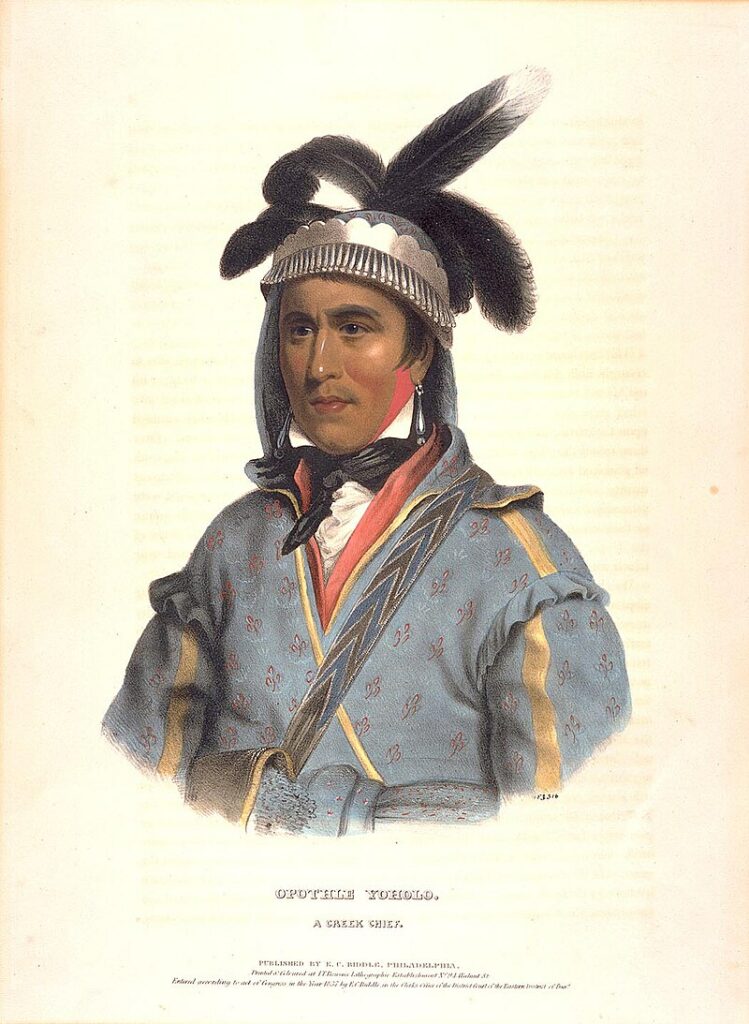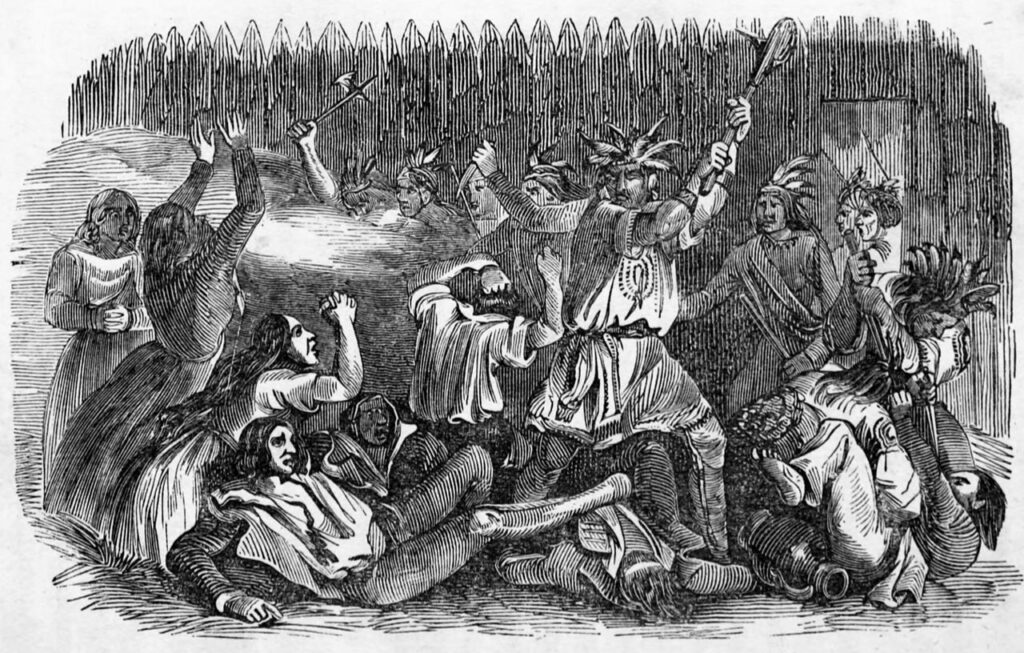Fort Mims State Historic Site, a vital landmark in American frontier history, captures the tumultuous interactions between white settlers and Native Americans in the early 19th century.
The site’s significance is underscored by the actions of Prophet Paddy Walsh and Creek militiamen amidst escalating tensions.
As the number of Indians grew, conflicts erupted, notably involving barrels of corn crucial to survival. Central to this was the Red Sticks’ cause, a militant faction resisting European encroachment.
The Fort Mims Massacre epitomizes the intense struggle, leaving an indelible mark on the region’s historical narrative.
Fort Mims Historic Site Overview

Fort Mims State Historic Site holds a significant place in American history. It saw the convergence of various cultures during a turbulent period in the southeastern United States frontier.
Mississippi Territory Origins
The Mississippi Territory, established in 1798, covers a vast area in the southeastern United States. It expanded as more settlers moved into the region.
Early conflicts between settlers and Native American tribes marked this period, shaping the area’s development. The escalating tensions and subsequent interactions laid the groundwork for the significant events at Fort Mims.
Samuel Mims and Early Settlement
Samuel Mims, a prominent settler, established a plantation in the Mississippi Territory. He built the fort in 1813 to protect local settlers amidst rising conflicts.
The fort provided a sanctuary for the settlers and black slaves, highlighting Samuel Mims’ role in the community. The settlement’s strategic location became crucial during the Creek War, significantly impacting the area’s history.
Creek Nation and Conflict

The Creek Nation was composed of various tribal factions and faced significant internal and external pressures that culminated in the Creek Indian War. The conflict was a defining moment, leading to critical shifts in power and territory.
The Creek Confederacy
The Creek Confederacy, also known as the Muscogee, consisted of several tribal townships in present-day Georgia and Alabama. These included both Upper Creeks and Lower Creeks.
The confederacy was a complex socio-political entity, with each township maintaining some autonomy.
Mixed-blood Creeks often held influential positions within this structure, bridging the cultural and political divides between Native American and European-American communities.
The central aim of the confederacy was to unify the various Creek towns for mutual defense and to manage interactions with settlers and colonial powers.
Tensions and Creek Indian War
Rising tensions between the Creek Nation and European-American settlers in the early 19th century escalated into the Creek Indian War (1813-1814). The Battle of Burnt Corn in July 1813 began open hostilities.
Creek leaders and warriors opposed encroachments on their lands and the imposition of foreign policies. External pressures from American expansionism and internal divisions within the Creek Nation exacerbated the conflict. The war severely disrupted Creek society, leading to significant casualties and the eventual ceding of large territories to the United States.
The Red Stick Faction
The Red Stick faction emerged as a militant group within the Creek Nation. It advocated for a return to traditional ways and resisting European-American influence. Named after its red-painted war clubs, it gained prominence during the war.
The Battle of Burnt Corn saw significant participation from this faction, igniting widespread conflict.
The faction’s objectives often clashed with those of other Creeks who favored peaceful relations with settlers, leading to a civil war within the Creek Nation.
The Red Sticks’ activities were a central aspect of the Creek Indian War and had lasting impacts on the Creek Confederacy’s structure and future.
Fort Mims Massacre

The Fort Mims Massacre, which occurred on August 30, 1813, was a critical and tragic event in American history marked by violent conflict at Fort Mims.
This attack had significant repercussions and involved key figures whose actions and aftermath influenced subsequent events.
The Attack
The attack on Fort Mims occurred around noon on August 30, 1813. The Creek warriors, led by Creek leader William Weatherford, also known as Red Eagle, breached the fort’s defenses.
Despite attempts to prepare, Major Daniel Beasley and his men were quickly overwhelmed. The fort, intended to protect settlers and allied Native Americans, failed to withstand the assault.
The attackers showed little mercy, killing a large number of civilians, including men, women, and children.
The estimated death toll ranges from 250 to 500, making it one of the bloodiest attacks on settlers in the region.
Notable Figures
William Weatherford (Red Eagle): Known for his leadership and strategic skills, Weatherford played a central role in the attack on Fort Mims. Born to a Creek mother and a Scottish father, he became a prominent figure in the Creek War.
Major Daniel Beasley: Beasley was the officer in charge at Fort Mims. His leadership during the attack was criticized, particularly for dismissing warnings of an impending assault. He was among the first to be killed as the attack began.
Captain Dixon Bailey: An allied Creek, Bailey fought bravely to defend Fort Mims. Despite his efforts, he was unable to prevent the overwhelming attack and was killed in the massacre.
Aftermath and Impact
The Fort Mims Massacre had immediate and far-reaching consequences. It galvanized American forces, leading to a more determined military response in the Creek War.
The brutal nature of the attack spurred widespread fear and anger among settlers, increasing support for military action against the Creek forces.
The Creek War saw significant battles, including the pivotal Battle of Horseshoe Bend in 1814, which curtailed Creek resistance and led to substantial territorial losses for the Creek Nation.
The massacre also affected relations with other Native American tribes and had lasting implications for the settlement patterns and security measures in the southeastern United States.
Strategic Significance
Fort Mims was crucial during the Creek War, impacting military strategies and subsequent battles. Its strategic importance is highlighted through military implications and connection to the Battle of Horseshoe Bend.
Military Implications
Fort Mims was a pivotal frontier fortress in the Creek War, influencing both Creek and U.S. military strategies.
It was built to protect settlers from Creek warriors, becoming a significant stronghold for federal troops and U.S.-allied Creeks.
The fort’s fall on August 30, 1813, had major repercussions. Over 500 settlers and militia were killed, galvanizing support for military campaigns against the Red Sticks faction.
This event changed the tide, drawing substantial federal military resources into the region.
Battle of Horseshoe Bend
The massacre at Fort Mims was a key motivator for the decisive Battle of Horseshoe Bend. General Andrew Jackson led federal troops along with U.S.-allied Creeks and launched a concerted attack on Red Eagle’s forces.
This battle, fought on March 27, 1814, effectively ended the Creek War. At Horseshoe Bend, Jackson’s forces overcame fortified Creek defenses, killing over 800 Creek warriors.
The victory compelled the Creeks to sign the Treaty of Fort Jackson, ceding vast tracts of land to the United States. This significantly altered the balance of power in the southeastern United States.
Explore More: Army Forts in Alabama
Preservation and Memorialization
The importance of maintaining Fort Mims State Historic Site is evident in the efforts of key organizations, focusing on historical accuracy and public engagement through restorations and annual events.
Alabama Historical Commission
The Alabama Historical Commission is vital in preserving the Fort Mims State Historic Site. This organization oversees the site’s upkeep, ensuring its historical significance is maintained for future generations.
They manage the placement of various historical markers around the site, providing visitors with detailed information about the events.
Additionally, their involvement includes creating educational programs to highlight the historical events associated with Fort Mims.
Fort Mims Restoration Efforts
Efforts to restore Fort Mims focus on historical accuracy and community involvement. The Fort Mims Restoration Association leads initiatives to reconstruct notable structures like the restored blockhouse.
These efforts include using period-authentic materials and techniques to maintain historical integrity.
The annual reenactment is a significant event organized to educate the public and honor those who experienced the historical events at Fort Mims.
This reenactment draws visitors and provides an engaging way to remember and understand the site’s history.
Cultural and Educational Aspects
Fort Mims State Historic Site offers rich cultural insights and educational experiences that highlight the intersection of Native American heritage and European-American history.
Red Stick Cultural Significance
The Red Stick faction of the Creek Native Americans held significant influence in the area. They were known for resisting European-American encroachment, reflecting the broader struggle of indigenous groups during that era.
The site features artifacts, such as red wooden war clubs, that symbolize their warrior culture and customs. Visitors can explore informative exhibits that detail Red Stick traditions, including their spiritual beliefs and societal structure.
The presentations emphasize the importance of understanding the varied and complex cultural makeup of early 19th-century Native American societies.
Visitor Engagement
The site has various facilities to enhance visitor engagement and ensure a comprehensive educational experience. Picnic tables are strategically placed to provide comfort during extended visits.
Guided tours offer detailed narratives about the site’s history and cultural significance. Interactive displays and educational programs cater to children and adults, making history accessible and engaging for all ages.
Workshops and reenactments are periodically held, allowing visitors to experience traditional customs firsthand.
These activities offer a deeper appreciation of the daily lives of Native Americans and European settlers, fostering a connection to the past through immersive learning experiences.
Explore More: 19 Historic Forts in Alabama
Modern Day Relevance
The Fort Mims State Historic Site is significant today due to its impact on economic and land development and its role in American history.
Economic and Land Development
Baldwin County has seen substantial benefits from the Fort Mims State Historic Site’s presence. The site’s surrounding land, including Fort Mims Road, has appreciated, boosting local real estate markets.
Increased visitation encourages investment in infrastructure. Tourism also helps businesses thrive, such as restaurants, souvenir shops, and hotels.
Preservation efforts create maintenance, education, and visitor management jobs, promoting sustainable development. This balance supports local economies and preserves historical integrity.
Fort Mims in American History
Fort Mims played a crucial role in the Creek War of 1813-1814, marking a pivotal moment in American and Indian lands history.
The site educates the public about conflicts between settlers and Native Americans and provides insight into early 19th-century frontier life.
Educational programs and reenactments foster a deeper appreciation for this historical context.
The pivotal events at Fort Mims continue to be referenced in academic research, books, and documentaries, maintaining its relevance in the narrative of American history.

Cory is a website owner and content creator who enjoys fishing, history, coin collecting, and sports, among other hobbies. He is a husband and father of four.
Romans 15:4 For whatever was written in former days was written for our instruction, that through endurance and through the encouragement of the Scriptures we might have hope.

